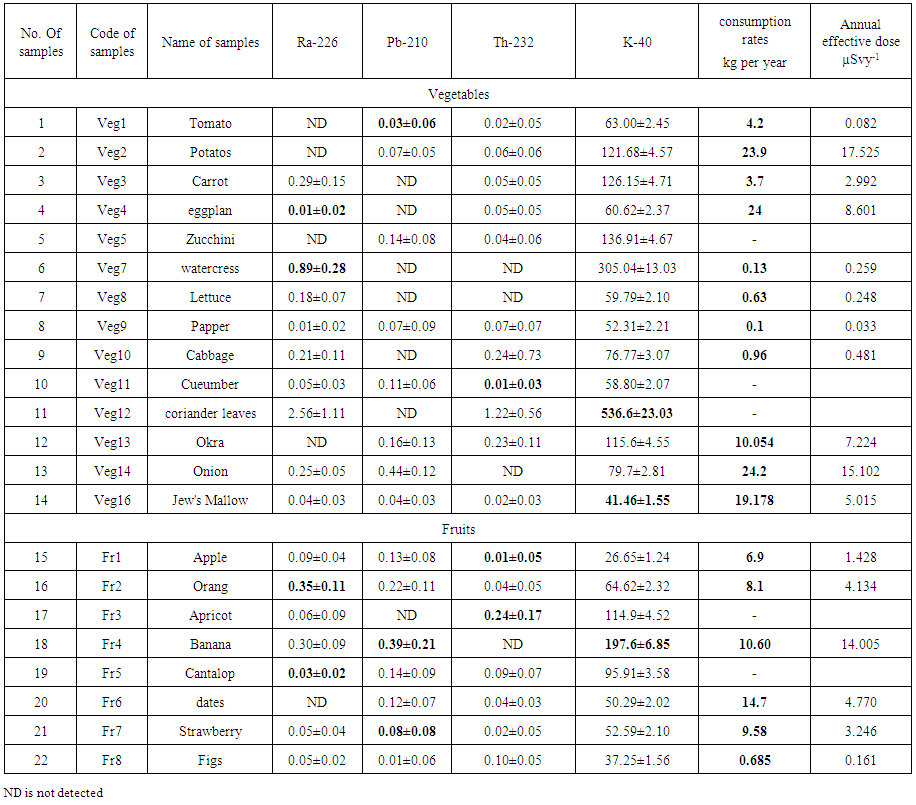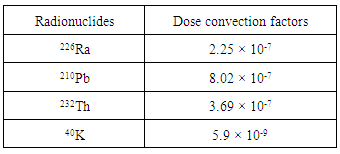-
Paper Information
- Paper Submission
-
Journal Information
- About This Journal
- Editorial Board
- Current Issue
- Archive
- Author Guidelines
- Contact Us
Journal of Nuclear and Particle Physics
p-ISSN: 2167-6895 e-ISSN: 2167-6909
2015; 5(3): 70-73
doi:10.5923/j.jnpp.20150503.04
Natural Radioactivity Concentration and Annual Effective Dose in Selected Vegetables and Fruits
S. Harb
Physics Department, Faculty of Science, South Valley University, Qena, Egypt
Correspondence to: S. Harb , Physics Department, Faculty of Science, South Valley University, Qena, Egypt.
| Email: |  |
Copyright © 2015 Scientific & Academic Publishing. All Rights Reserved.
The aims of this study are to determine the mean concentrations of important natural radionuclides and annual effective dose due to the ingestion of Vegetables and Fruits in Qena, Upper Egypt. The levels of 226Ra, 210Pb, 232Th, and 40K were measured in some vegetables and fruits samples were collected from local market in Qena. The content of 226Ra, 210Pb, 232Th, and 40K radioactivity varies from 0.01±0.02 to 2.56±1.11, 0.01±0.06 to 1.06±0.26, 0.01±0.05 to 1.22±0.56, and 26.65±1.24 to (536.64±23.03) Bq.kg-1, respectively.
Keywords: Gamma-ray, Gamma spectrometry, HPGe detector, Natural radionuclids, Vegetables and fruits
Cite this paper: S. Harb , Natural Radioactivity Concentration and Annual Effective Dose in Selected Vegetables and Fruits, Journal of Nuclear and Particle Physics, Vol. 5 No. 3, 2015, pp. 70-73. doi: 10.5923/j.jnpp.20150503.04.
Article Outline
1. Introduction
- Natural radioactivity arises mainly from the primordial radionuclides, such as 40K, and the radionuclides from the 238U and 232Th and their decay products, which are present at trace levels in all ground formations. The knowledge of concentrations and distributions of the radionuclides in these materials are of interest since it provides useful information in the monitoring of environmental radioactivity.Natural radionuclides occur in soil and they are incorporated metabolically into plants, and ultimately find their way into food and water. Manmade radionuclides behave in a similar manner, and worldwide contamination of the food chains by radionuclides produced during tests of nuclear weapons in the atmosphere has taken place during the past half century [2]. (Golmakani et al 2008).In some parts of the world, population growth and movement, industrial development and food security have resulted in pressure to use agricultural lands containing relatively high levels of radioactivity, for instance in the monazite areas of India and Brazil, and in parts of Iran with 226Ra anomalies where exposures up to tens of mSv, and in extreme cases 100 mSv, occur annually (UNSCEAR, 2000; Banzi et al., 2000) [1, 2].In the present work levels of 226Ra, 210Pb, 232Th, and 40K in daily diets were determined in selected vegetables and fruits in Qena, Egypt. The obtained results were used for the estimation of intakes, and annual effective doses of these radionuclides in the adult population of Qena, Egypt.
2. Materials and methods
2.1. Sampling and Preparing
- Twenty – Two vegetables and fruits samples were collected from the local market selected according to use at Qena, Upper Egypt as shown in fig 1. The foodstuff samples were washed with normal water, as for human consumption, weighed and divided into small parts, dried in a stove at a temperature of 80°C for 48 h and ground into powder (Harb, Santos) [3, 4], and filled in 250 mL polypropylene bottles, which were sealed and left for at least 4 weeks before counting by gamma spectrometry in order to ensure that radioactive secular equilibrium.
 | Figure 1. Map of Sampling location (Qena city) |
2.2. Gamma Spectrometry
2.2.1. Instrumentation
- Direct determination of radionuclides in vegetables and fruits samples without any chemical treatment was performed at the Institute for Radioecology and Radiation Protection (IRS), Hanover University, Germany, using a p-type HPGe coaxial detector (GEM 50198-P) of 35% relative efficiency, with a resolution of 1.78 keV at 1.332 MeV. It is shielded with 10 cm lead and 2 mm copper, and coupled to an 8192-channel analyzer (Harb 2008) [5].
2.2.2. Efficiency and Calibration
- The counting efficiencies of the γ-ray peaks were measured by using QCY48 and QCY40 standard solutions (Physikalisch-Technische Bundesanstalt PTB Germany) and were determined using a certified standard solution containing 210Pb, 57Co, 60Co, 85Sr, 88Y, 109Cd, 113Sn, 139Ce, 137Cs, and 241Am. The geometry of the experimental samples was the same as that of the standard samples (Harb 2008) [5].
2.3. Measurements and Calculation
2.3.1. Calculation of Radionuclides
- Following the spectrum analysis, counting rates for each detected photopeak and activity per mass unit for each of the detected nuclides are calculated. The specific activity (in Bq·kg-1) is given by Harb 2004 [6]
 | (1) |
|
 | Table 2. The activity concentration of 226Ra, 210Pb, 232Th, and 40K (in Bqkg-1) in some fresh vegetables and fruits and Annual effective dose µSvy-1 |
2.3.2. Calculation of the Annual Effective Dose
- Calculation of the annual effective dose due to the ingestion of foods was performed based on the metabolic model developed by the International Commission of Radiological Protection [8]. The effective dose (Drf ) from a radionuclide (r) in a foodstuff (f ) can be determined by Nasreddine [9]
 | (2) |
3. Results and Discussions
- In total, 22 samples have been analysed (8 fruits and 14 vegetables). From the table 2 we can see that the range of concentration are 0.01±0.02 to 2.56±1.11, 0.01±0.06 to 0.39±0.21, 0.01±0.05 to 1.22±0.56, and 26.65±1.24 to 536.6±23.03226 Ra, 210Pb, 232Th, and 40K respectively. Since phosphate fertilizers may contain considerable levels of radionuclides from uranium, thorium series and 40K, their use in order to increase yield can increase the radionuclide contents in vegetables and as consequence this may raise the internal dose to consumers due to food consumption. The objective of this research was to investigate the influence of fertilizers and agricultural management on 210Pb, 226Ra, 232Th and 40K contents in vegetables. The concentrations of radium and Thorium in the most commonly used Egyptian phosphate and organic fertilizers were determined as well as soil to plant transfer factors for lettuce and carrot [13, 9].
4. Conclusions
- This study was described the dose rate intake of gamma-emitting radionuclides for the Upper Egyptian consumer. This studying showed that the activity concentration of the gamma-emitting radionuclide 226Ra, 210Pb, 232Th, and 40K in fruits and vegetables available on Qena City market were 0.01±0.02 to 2.56±1.11, 0.01±0.06 to 0.39±0.21, 0.01±0.05 to 1.22±0.56, and 26.65±1.24 to 536.6±23.03 Bqkg-1 respectively. The Range annual effective dose from dietary intake of 226Ra, 210Pb, 232Th, and 40K are estimated from 0.033 to 17.525 µSvy-1.
ACKNOWLEDGMENTS
- The author thank Prof. Dr. C. Walther, Director of Institute for Radioecology and Radiation Protection (IRS), Hannover University, Germany, for his encouragement and support.
 Abstract
Abstract Reference
Reference Full-Text PDF
Full-Text PDF Full-text HTML
Full-text HTML